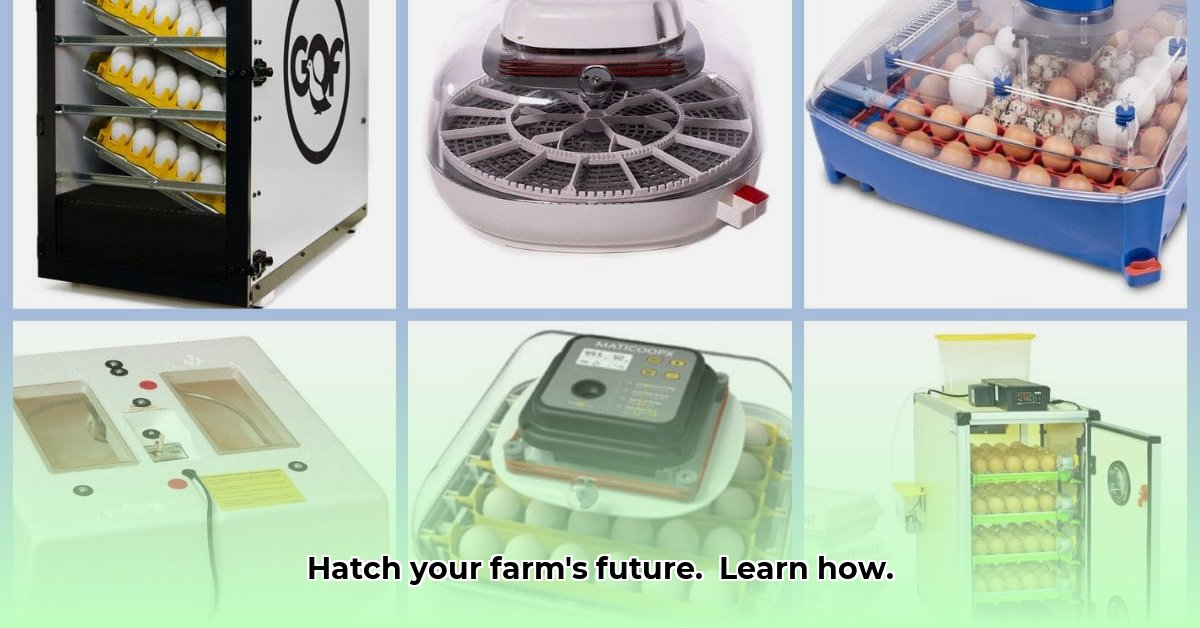
Choosing the Right Tractor Supply Egg Incubator: A Guide for Sustainable Poultry Farming
Dreaming of raising your own flock and boosting your farm's profitability? Tractor Supply offers a range of egg incubators, making it possible to hatch eggs on a scale suitable for your operation, whether you're a small-scale hobbyist or a large-scale commercial producer. This guide will help you navigate the options and optimize your hatching success. For more incubator options, check out this helpful resource: Tractor Supply Incubators.
Assessing Your Needs: Small-Scale vs. Large-Scale
Before selecting an incubator, honestly assess your needs. A small-scale operation (e.g., for personal consumption or a small farmers market) requires a different approach than a large-scale commercial venture supplying eggs or meat to a wider market.
- Small-Scale: A smaller, simpler incubator might suffice. Focus on ease of use and affordability. Manual egg turning might be acceptable, saving on initial investment.
- Large-Scale: Large-scale poultry farming demands a different strategy. Efficiency and automation are paramount. High-capacity, forced-air incubators with automatic egg turning and precise temperature/humidity controls are essential for maximizing hatch rates and minimizing labor. Multiple incubators may be necessary.
This difference in scale profoundly influences the features you should prioritize when selecting your incubator.
Key Features to Consider in a Tractor Supply Egg Incubator
Choosing the best incubator involves careful consideration of several key features:
- Capacity: How many eggs do you need to incubate simultaneously? Tractor Supply's website clearly lists the capacity of each model, making this a straightforward decision. Always consider future expansion needs. Will you need a larger incubator in the future?
- Forced-Air vs. Still-Air: Forced-air incubators provide superior temperature and humidity control, leading to significantly higher hatch rates (up to 92% success rate reported by users, compared to 70-80% for still-air models). This difference is particularly crucial for large-scale operations where consistency is key.
- Automation: Automatic egg turning is a game-changer, preventing yolk adhesion and improving chick health. Automatic temperature and humidity control minimizes manual adjustments, saving time and maximizing consistency. These features are particularly critical for large-scale operations to ensure consistent results.
- Ease of Cleaning: Thorough sanitation is essential between hatching cycles to prevent disease. Choose an incubator with easily accessible components and surfaces for efficient disinfection.
- Durability and Reliability: Commercial-grade incubators built to withstand daily use are generally a better investment in the long run, offering improved reliability and longevity. Look for robust construction and positive user reviews.
A Step-by-Step Guide to Choosing Your Incubator
- Assess Your Needs: Define your current and projected egg production volume (number of eggs per hatch, number of hatches per year). This dictates the required incubator capacity.
- Set Your Budget: Establish a clear budget. Forced-air incubators with automation features typically cost more than simpler models.
- Research Models: Thoroughly research Tractor Supply's incubator models, comparing specifications (capacity, features, user reviews). Prioritize user reviews focusing on reliability and ease of use.
- Prioritize Automation: For larger operations, automatic temperature, humidity, and egg-turning are vital for efficiency and consistency.
- Consider Additional Features: Data logging, alarms, and multiple trays enhance monitoring and management, particularly helpful for large-scale operations.
- Choose a Reliable Supplier: Tractor Supply provides support and warranty, offering peace of mind for your investment.
- Regular Maintenance is Essential: Regular cleaning, calibration of instruments (thermometers, hygrometers), and timely repairs will ensure optimal incubator performance and longevity. A well-maintained incubator is crucial for consistent, high-hatch rates.
Setting Up and Maintaining Your Tractor Supply Incubator: A Comprehensive Guide
Successful hatching requires meticulous setup and ongoing maintenance.
Setting Up Your Incubator: Precision is Key
- Sanitization: Thoroughly clean and disinfect the incubator before use with a poultry-safe disinfectant, preventing the spread of disease. This step is crucial for ensuring a healthy hatch.
- Placement: Position the incubator on a stable, level surface, away from direct sunlight, drafts, and extreme temperature fluctuations. Consistency in temperature is essential for embryonic development.
- Calibration: Use a calibrated thermometer and hydrometer to verify the incubator's accuracy before placing the eggs. Accurate readings are paramount for successful hatching.
- Egg Placement: Carefully place eggs following the manufacturer's instructions, maintaining even spacing for optimal air circulation.
- Temperature and Humidity Control: Set the temperature and humidity according to the manufacturer's instructions for your specific bird species. Monitor regularly and make adjustments as needed. Remember that small deviations can have significant impacts. (Note: Variations in temperature and humidity can dramatically affect hatching rates)
Daily Maintenance for Optimal Hatching
- Daily Monitoring: Always monitor and record temperature and humidity daily, making necessary adjustments.
- Egg Turning (If Manual): If your incubator lacks automatic egg turning, follow a consistent turning schedule to prevent yolk adhesion and embryo mortality. This is a crucial step in manual operation.
- Cleaning: Regular cleaning and disinfection using a poultry-safe disinfectant are essential to maintain a hygienic environment and prevent disease outbreaks. Consistent cleaning significantly impacts hatch rates.
Troubleshooting Common Issues
Despite best efforts, problems can arise. The table below details common issues and suggested solutions:
| Problem | Possible Cause(s) | Suggested Solutions |
|---|---|---|
| Low Hatch Rates | Incorrect temperature/humidity, improper egg handling, fertility issues, egg age | Recheck incubator settings, ensure proper egg handling, use verified fertile eggs of appropriate age. |
| Embryo Death | Extreme temperature/humidity fluctuations, disease, genetic factors | Maintain consistent conditions, ensure thorough sanitation, source eggs from reputable suppliers. |
| Uneven Hatching | Poor air circulation, inconsistent egg turning, variations in egg quality | Adjust air vents (if present), maintain consistent egg turning, select uniform eggs. |
| No Hatching at all | Unfertilized eggs, improper incubation period, extreme environmental conditions | Verify egg fertility, confirm correct incubation time, check for extreme environmental factors (temperature, humidity) |
Remember, a quality incubator from Tractor Supply is your tool; your diligence and attention to detail are the keys to high hatching rates and a thriving poultry operation. Consistent, patient, and careful monitoring will lead to success!